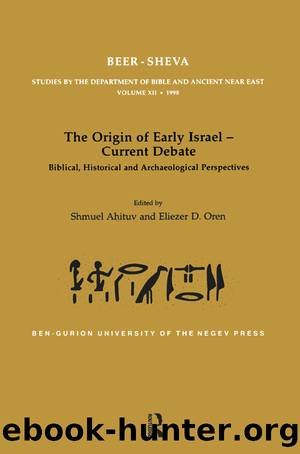The Origin of Early Israel-Current Debate by Shmuel Ahituv Eliezar Oren

Author:Shmuel Ahituv, Eliezar Oren [Shmuel Ahituv, Eliezar Oren]
Language: eng
Format: epub
ISBN: 9781598743913
Barnesnoble:
Goodreads: 5969188
Publisher: Taylor & Francis
Published: 1998-01-01T00:00:00+00:00
V. Into Canaan
Nearly everyone is agreed, at least, that sooner or later an ancient Hebrew community of some kind came into being in Canaan, and in most opinions before the Babylonian conquest of Palestine in the early 6th century BCE. Biblical tradition has an entry under a figure Joshua, followed by a slow consolidation under largely local Hebrew non-professional leaders (the so-called âjudgesâ), culminating in a kingdom, unitary in the late 11th to 10th centuries BCE, then split into two rump-kingdoms thereafter. With one exception, external attestation begins in the 9th century BCE. Very naively, one wing of biblical studies draws the over-simplistic conclusion: âno mentions of Hebrews and their kingdoms in Palestine before 853 BCE â ergo, no Hebrews and their kingdoms ever existed in Palestine before c. 900 BCEâ. However, this view omits totally to look at the nature of the evidence and at its extent. The only reason we have no external attestations before 853 BCE is simply that the Assyrians had not previously reached so far south in central Syria, having thus no contact with any kingdoms still further south, such as Israel, Judah, Philistia, and the Transjordanian entities. Hence, in this situation, no mention = no contact, not necessarily non-existence. And such a negative view is categorically disproved from two directions: Egypt and Syria. In 925 BCE, Shoshenq I raided Palestine, in the areas of both Judah and Israel, and both west and east of the Jordan. That his stela and great triumphal scene and name-list is telling the truth is backed up to the hilt by the discovery of his victory stela at Megiddo.119 If nothing in Kings and Chronicles was invented until the Babylonian Exile or later, exiled Jewish would-be chroniclers in Babylonia (or even in impoverished Achaemenid Palestine) could never have known of Shisha(n)q, our Shoshenq. And, as (properly calibrated on Near-Eastern principles) the Hebrew datelines in Kings and Chronicles give a correct correlation in the 10th century BCE with the independently calculated dates for Shoshenq I,120 it becomes clear that the entire chronological/chronicular framework of Kings rests upon fact, not fancy, whatever one might choose to make of particular historical/narrative details. Hence, ancient Israel and Judah do go back as entities to at least the late 10th century BCE on good Egyptian evidence. From Dan, we also have the now notorious Aramean stela which, beyond any serious doubt, does mention âthe house [=dynasty] of Davidâ, and the near-contemporary death/defeat of kings of both Israel and that other house, i.e. Judah. This sets its date to not later than c. 841 BCE, with the deaths of Joram of Judah and Ahaziah of Israel, giving us a definition then of Judah as a dynastic realm of somebody David. It is nonsensical to see in this name anyone other than the David whose figure stands tall in the Hebrew Bible not only in the accounts of his reign but also in the writings of later generations.121 A reference in the Moabite Stela hardly much
Download
This site does not store any files on its server. We only index and link to content provided by other sites. Please contact the content providers to delete copyright contents if any and email us, we'll remove relevant links or contents immediately.
Never by Ken Follett(2942)
Machine Learning at Scale with H2O by Gregory Keys | David Whiting(2353)
The Man Who Died Twice by Richard Osman(2328)
Fairy Tale by Stephen King(2129)
Will by Will Smith(2101)
Reminders of Him: A Novel by Colleen Hoover(1929)
Rationality by Steven Pinker(1790)
The Stranger in the Lifeboat by Mitch Albom(1580)
New Morning Mercies: A Daily Gospel Devotional by Paul David Tripp(1438)
Friends, Lovers, and the Big Terrible Thing by Matthew Perry(1372)
The Becoming by Nora Roberts(1356)
A Short History of War by Jeremy Black(1319)
The Strength In Our Scars by Bianca Sparacino(1316)
HBR's 10 Must Reads 2022 by Harvard Business Review(1271)
Can't Hurt Me: Master Your Mind and Defy the Odds - Clean Edition by David Goggins(1255)
The Fall of Babel by Josiah Bancroft(1254)
515945210 by Unknown(1225)
Love on the Brain by Ali Hazelwood(1156)
Fear No Evil by James Patterson(1129)
